Nano- to Millimeter Scale Morphology of Connected and Isolated Porosity in the Permo-Triassic Khuff Formation of Oman
Abstract
:1. Introduction
Geological Setting
2. Methods and Materials
2.1. Samples and Workflow
2.2. 2D Imaging
2.3. Mercury Injection Capillary Pressure (MICP)
2.4. Electric Resistivity Measurement
2.5. Micro-Computed Tomography (µCT)
2.6. Nuclear Magnetic Resonance (NMR)
3. Results
3.1. Petrographic Observations and Pore-Size Distributions
3.2. Pore-Throat Size-Distribution
3.3. Electric Resistivity Measurement
3.4. Micro-Computed Tomography (µCT)
3.5. NMR
3.6. Porosity vs. Permeability
3.7. Rock Typing
4. Discussion
5. Conclusions
Author Contributions
Funding
Acknowledgments
Conflicts of Interest
References
- Burchette, T.P. Carbonate Rocks and Petroleum Reservoirs: A Geological Perspective from the Industry. Geol. Soc. Lond. Spec. Publ. 2012, 370, 17–37. [Google Scholar] [CrossRef]
- Ghous, A.; Senden, T.J.; Sok, R.M.; Sheppard, A.P.; Pinczewski, V.W.; Knackstedt, M.A. 3D Characterisation of Microporosity in Carbonate Cores. In SPWLA Middle East Regional Symposium; Society of Petrophysicists and Well-Log Analysts: Houston, TX, USA, 2007; SPWLA-MERS-2007-E. [Google Scholar]
- Geiger, S. Quantifying the Dynamic Behavior of Multi-Porosity Systems in Carbonates—Challenges, Perspectives and Opportunities. Presented at the Mountjoy Carbonate Research Conference, Austin, TX, USA, 25–29 June 2017. [Google Scholar]
- Baechle, G.T.; Colpaert, A.; Eberli, G.P.; Weger, R.J. Effects of Microporosity on Sonic Velocity in Carbonate Rocks. Lead. Edge 2008, 27, 1012–1018. [Google Scholar] [CrossRef]
- Harland, S.R.; Wood, R.A.; Curtis, A.; van Dijke, M.; Stratford, K.; Jiang, Z.; Kallel, W.; Sorbie, K. Understanding the Role of Micropores in Fluid Flow within Carbonate Reservoirs. Geol. Soc. Am. 2016, 48. [Google Scholar] [CrossRef]
- Hollis, C.; Al Hajri, A.; Archilha, N.L.; Ceia, M.; Lacey, M.; Lee, P.; McDonald, S.; Missagia, R. Pore Topology and Rock Physical Properties of Microporosity in Lower Cretaceous Carbonate Sediments: Insights from X-Ray Ct Imaging. Presented at the Mountjoy Carbonate Research Conference, Austin, TX, USA, 25–29 June 2017. [Google Scholar]
- Choquette, P.W.; Cox, A.; Meyers, W.J. Characteristics, Distribution and Origin of Porosity in Shelf Dolostones: Burlington-Keokuk Formation (Mississippian), U.S. Mid-Continent. SEPM J. Sediment. Res. 1992, 62, 167–189. [Google Scholar] [CrossRef]
- Knackstedt, M.A.; Latham, S.; Madadi, M.; Sheppard, A.; Varslot, T.; Arns, C. Digital Rock Physics: 3D Imaging of Core Material and Correlations to Acoustic and Flow Properties. Lead. Edge 2009, 28, 28–33. [Google Scholar] [CrossRef]
- Smodej, J.; Reuning, L.; Becker, S.; Kukla, P.A. Micro- and Nano-Pores in Intrasalt, Microbialite-Dominated Carbonate Reservoirs, Ara Group, South-Oman Salt Basin. Mar. Pet. Geol. 2019, 104, 389–403. [Google Scholar] [CrossRef]
- Washburn, E.W. The Dynamics of Capillary Flow. Phys. Rev. 1921, 17, 273–283. [Google Scholar] [CrossRef]
- Słowakiewicz, M.; Perri, E.; Tucker, M.E. Micro- and Nanopores in Tight Zechstein 2 Carbonate Facies from the Southern Permian Basin, Nw Europe. J. Pet. Geol. 2016, 39, 149–168. [Google Scholar] [CrossRef]
- Borrelli, M.; Campilongo, G.; Critelli, S.; Ida, D.P.; Perri, E. 3D Nanopores Modeling Using Tem-Tomography (Dolostones—Upper Triassic). Mar. Pet. Geol. 2019, 99, 443–452. [Google Scholar] [CrossRef]
- Desbois, G.; Urai, J.L.; Kukla, P.A. Morphology of the Pore Space in Claystones—Evidence from Bib/Fib Ion Beam Sectioning and Cryo-Sem Observations. eEarth 2009, 4, 15–22. [Google Scholar] [CrossRef]
- Desbois, G.; Urai, J.L.; Kukla, P.A.; Konstanty, J.; Baerle, C. High-Resolution 3D Fabric and Porosity Model in a Tight Gas Sandstone Reservoir: A New Approach to Investigate Microstructures from mm- to nm-Scale Combining Argon Beam Cross-Sectioning and SEM Imaging. J. Pet. Sci. Eng. 2011, 78, 243–257. [Google Scholar] [CrossRef]
- Nader, F.H.; De Boever, E.; Gasparrini, M.; Liberati, M.; Dumont, C.; Ceriani, A.; Morad, S.; Lerat, O.; Doligez, B. Quantification of Diagenesis Impact on the Reservoir Properties of the Jurassic Arab D and C Members (Offshore, U.A.E.). Geofluids 2013, 13, 204–220. [Google Scholar] [CrossRef]
- De Boever, E.; Foubert, A.; Oligschlaeger, D.; Claes, S.; Soete, J.; Bertier, P.; Özkul, M.; Virgone, A.; Swennen, R. Multiscale Approach to (Micro)Porosity Quantification in Continental Spring Carbonate Facies: Case Study from the Cakmak Quarry (Denizli, Turkey). Geochem. Geophys. Geosyst. 2016, 17, 2922–2939. [Google Scholar] [CrossRef] [Green Version]
- Da Silva, G.P., Jr.; Franco, D.R.; Stael, G.C.; de Oliveira Lima, M.D.; Martins, R.S.; de Moraes França, O.; Azeredo, R.B. Petrophysical Studies of North American Carbonate Rock Samples and Evaluation of Pore-Volume Compressibility Models. J. Appl. Geophys. 2015, 123, 256–266. [Google Scholar] [CrossRef]
- Volkmann, J.; Klitzsch, N. Wideband Impedance Spectroscopy from 1Mhz to 10Mhz by Combination of Four- and Two-Electrode Methods. J. Appl. Geophys. 2015, 114, 191–201. [Google Scholar] [CrossRef] [Green Version]
- Pillevuit, A. Les Blocs Exotiques Du Sultanat D’oman: Évolution Paléogéographique D’une Marge Passive Flexurale, Mèmoires De Géologie; Université de Lausanne, Faculté des sciences, Institut de géologie et de paléontologie: Lausanne, Switzerland, 1993. [Google Scholar]
- Konert, G.; Afifi, A.M.; Al-Hajri, S.I.; De Groot, K.; Al Naim, A.A.; Droste, H.J. Paleozoic Stratigraphy and Hydrocarbon Habitat of the Arabian Plate 1. In Petroleum Provinces of the Twenty-First Century; Marlan, W., Downey, J., Threet, C., William, A., Eds.; American Association of Petroleum Geologists: Morgan, LA, USA, 2001. [Google Scholar] [CrossRef]
- Ehrenberg, S.N.; Nadeau, P.H.; Aqrawi, A.A. A Comparison of Khuff and Arab Reservoir Potential Throughout the Middle East. AAPG Bull. 2007, 91, 275–286. [Google Scholar] [CrossRef]
- Koehrer, B.; Zeller, M.; Aigner, T.; Poeppelreiter, M.; Milroy, P.; Forke, H.; Al-Kindi, S. Facies and Stratigraphic Framework of a Khuff Outcrop Equivalent: Saiq and Mahil Formations, Al Jabal Al-Akhdar, Sultanate of Oman. GeoArabia 2010, 15, 91–156. [Google Scholar]
- Sharland, P.R.; Archer, R.; Casey, D.M.; Davies, R.B.; Hall, S.H.; Heward, A.P.; Horbury, A.D.; Simmons, M.D. Arabian Plate Sequence Stratigraphy. GeoArabia 2013, 18, 371. [Google Scholar]
- Alway, R.H.; Broomhall, R.W.; Hulstrand, R.F.; Al-Mansoori, A.; Abdalla, A.A.; Al-Aidarous, A. Sequence Stratigraphy of the Khuff Formation Comparing Subsurface and Outcrop Data (Arabian Plate, U.A.E.). In Proceedings of the Abu Dhabi International Petroleum Exhibition and Conference, Abu Dhabi, UAE, 13–16 October 2002; Society of Petroleum Engineers: Richardson, TX, USA, 2002. [Google Scholar] [CrossRef]
- Esrafili-Dizaji, B.; Rahimpour-Bonab, H. Effects of Depositional and Diagenetic Characteristics on Carbonate Reservoir Quality: A Case Study from the South Pars Gas Field in the Persian Gulf. Pet. Geosci. 2009, 15, 325–344. [Google Scholar] [CrossRef]
- Remeysen, K.; Swennen, R. Application of Microfocus Computed Tomography in Carbonate Reservoir Characterization: Possibilities and Limitations. Mar. Pet. Geol. 2008, 25, 486–499. [Google Scholar] [CrossRef]
- Maurer, F.; Martini, R.; Rettori, R.; Hillgärtner, H.; Cirilli, S. The Geology of Khuff Outcrop Analogues in the Musandam Peninsula, United Arab Emirates and Oman. GeoArabia 2009, 14, 125–158. [Google Scholar]
- Martin, A.Z. Late Permian to Holocene Paleofacies Evolution of the Arabian Plate and Its Hydrocarbon Occurrences. GeoArabia 2001, 6, 445–504. [Google Scholar]
- Koehrer, B.; Aigner, T.; Forke, H.; Pöppelreiter, M. Middle to Upper Khuff (Sequences KS1 to KS4) Outcrop-Equivalents in the Oman Mountains: Grainstone Architecture on a Subregional Scale. GeoArabia 2012, 17, 59–104. [Google Scholar]
- Roduit, N. Jmicrovision: Image Analysis Toolbox for Measuring and Quantifying Components of High-Definition Images. Available online: http://www.jmicrovision.com (accessed on 2 June 2015).
- Sigal, R.F. A Methodology for Blank and Conformance Corrections for High Pressure Mercury Porosimetry. Meas. Sci. Technol. 2009, 20, 045108. [Google Scholar] [CrossRef]
- Spagnoli, G.; Klitzsch, N.; Fernandez-Steeger, T.; Feinendegen, M.; Rey, A.R.; Stanjek, H.; Azzam, R. Application of Electro-Osmosis to Reduce the Adhesion of Clay During Mechanical Tunnel Driving. Environ. Eng. Geosci. 2011, 17, 417–426. [Google Scholar] [CrossRef]
- Archie, G.E. The Electrical Resistivity Log as an Aid in Determining Some Reservoir Characteristics. Trans. AIME 1942, 146, 54–62. [Google Scholar] [CrossRef]
- Kozeny, J. Ueber Kapillare Leitung Des Wassers. Boden. Sitz. Wien. Akad. 1927, 136, 271–306. [Google Scholar]
- Carman, P.C. Fluid Flow through Granular Beds. Chem. Eng. Res. Des. 1997, 75, S32–S48. [Google Scholar] [CrossRef]
- Perona, P.; Malik, J. Scale-Space and Edge Detection Using Anisotropic Diffusion. IEEE Trans. Pattern Anal. Mach. Intell. 1990, 12, 629–639. [Google Scholar] [CrossRef] [Green Version]
- Otsu, N.A. Threshold Selection Method from Gray-Level Histograms. IEEE Trans. Syst. Man Cybern. 1979, 9, 62–66. [Google Scholar] [CrossRef] [Green Version]
- Canny, J. A Computational Approach to Edge Detection. In Readings in Computer Vision; Elsevier: Amsterdam, The Netherlands, 1987; pp. 184–203. [Google Scholar] [CrossRef]
- Coates, G.R.; Xiao, L.; Prammer, M.G. NMR Logging Principles and Applications; Haliburton Energy Services: Houston, TX, USA, 2001. [Google Scholar]
- Kenyon, W.E. Petrophysical Principles of Applications of NMR Logging. Log Anal. 1997, 38, 23. [Google Scholar]
- Marschall, D.; Gardner, J.; Mardon, D.; Coates, G. Method for Correlating NMR Relaxometry and Mercury Injection Data. Available online: http://www.jgmaas.com/SCA/1995/SCA1995-11.pdf (accessed on 17 October 2019).
- Kenyon, W.E.; Day, P.I.; Straley, C.; Willemsen, J.F. A Three-Part Study of Nmr Longitudinal Relaxation Properties of Water-Saturated Sandstones. SPE Form. Eval. 1988, 3, 622–636. [Google Scholar] [CrossRef]
- Chang, D.; Vinegar, H.J.; Morriss, C.; Straley, C. Effective Porosity, Producible Fluid and Permeability in Carbonates from NMR Logging; Society of Petrophysicists and Well-Log Analysts: Houston, TX, USA, 1994. [Google Scholar]
- Vincent, B.; Fleury, M.; Santerre, Y.; Brigaud, B. NMR Relaxation of Neritic Carbonates: An Integrated Petrophysical and Petrographical Approach. J. Appl. Geophys. 2011, 74, 38–58. [Google Scholar] [CrossRef]
- Talabi, O.; Alsayari, S.; Fernø, M.A.; Riskedal, H.; Graue, A.; Blunt, M.J. Pore-Scale Simulation of NMR Response in Carbonates. In Proceedings of the International Symposium of the Society of Core Analysis, Abu Dhabi, UAE, 29 October–2 November 2008. [Google Scholar]
- Adam, A.; Swennen, R.; Abdulghani, W.; Abdlmutalib, A.; Hariri, M.; Abdulraheem, A. Reservoir Heterogeneity and Quality of Khuff Carbonates in Outcrops of Central Saudi Arabia. Mar. Pet. Geol. 2018, 89, 721–751. [Google Scholar] [CrossRef]
- Ehrenberg, S.N. Porosity Destruction in Carbonate Platforms. J. Pet. Geol. 2006, 29, 41–52. [Google Scholar] [CrossRef]
- Videtich, P.E. Dolomitization and H2S Generation in the Permian Khuff Formation, Offshore Dubai, U.A.E. Carbonates Evaporites 1994, 9, 42–57. [Google Scholar] [CrossRef]
- Alqassab, H.; Fullmer, S.M.; Alharbi, M.; Moore, P.J.; Kelly, B. Pore System Heterogeneity: Impact on Reservoir Modeling and Field Development. In Proceedings of the Mountjoy Carbonate Research Conference, Austin, TX, USA, 25–29 June 2017. [Google Scholar]



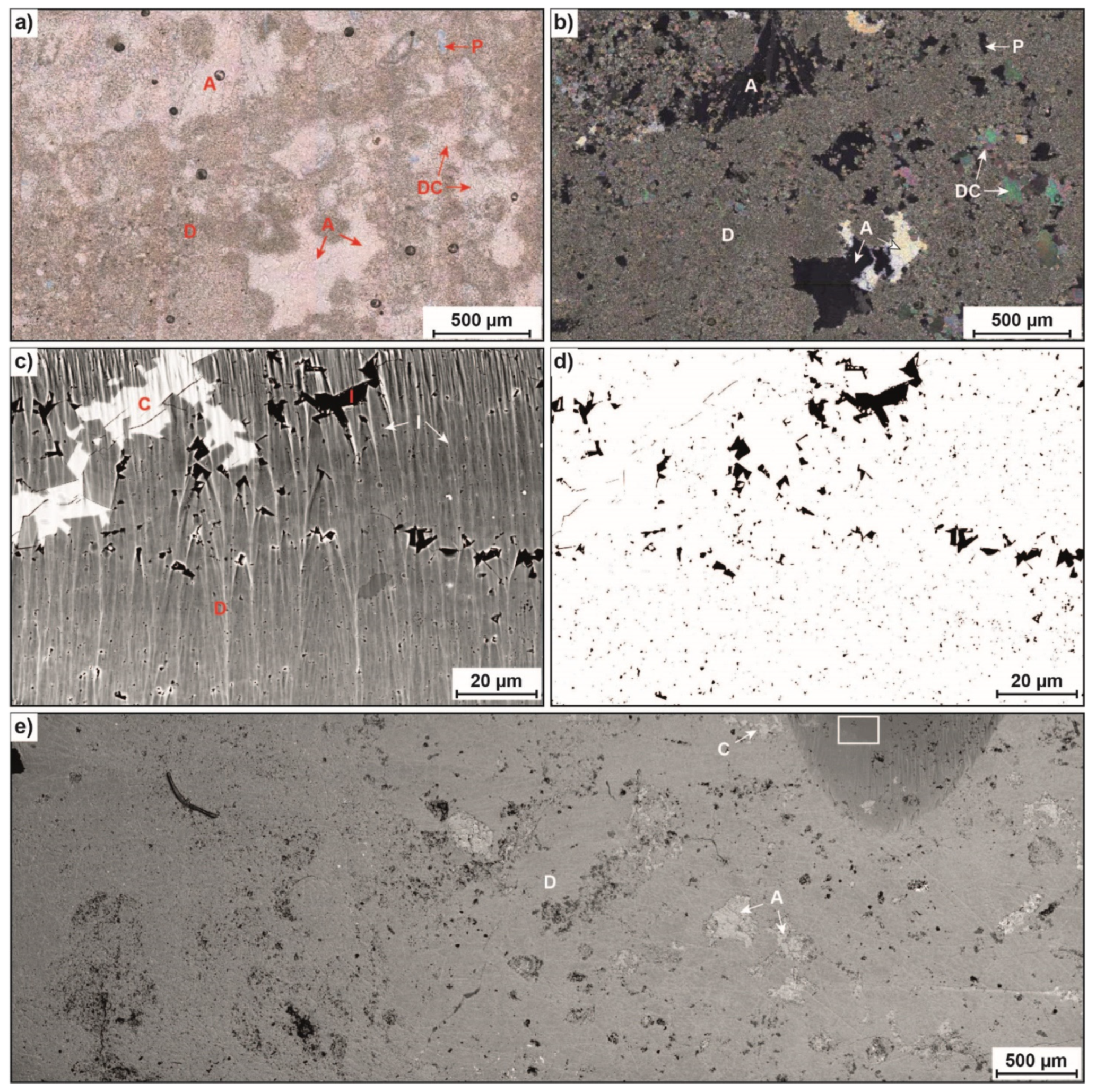
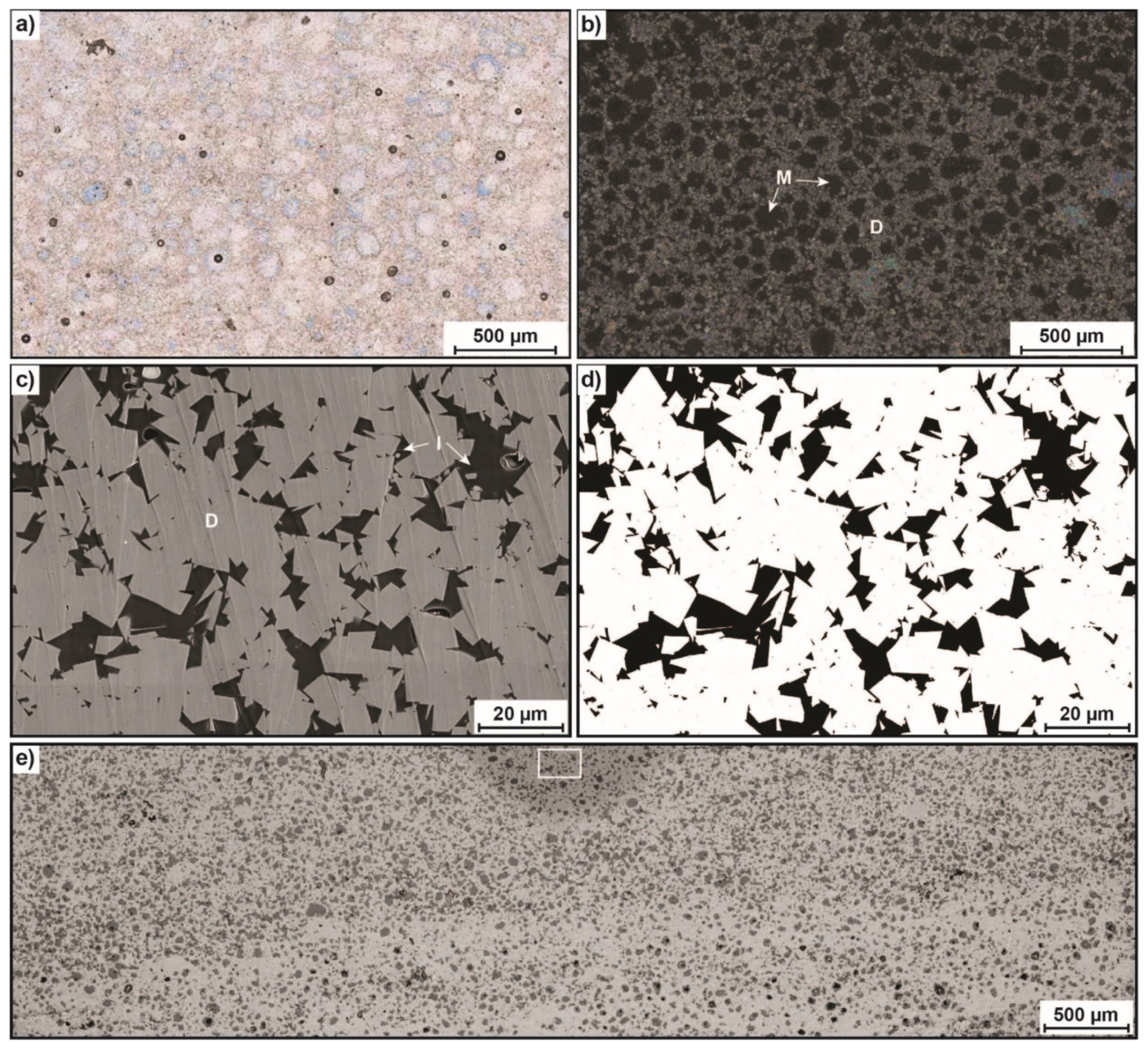

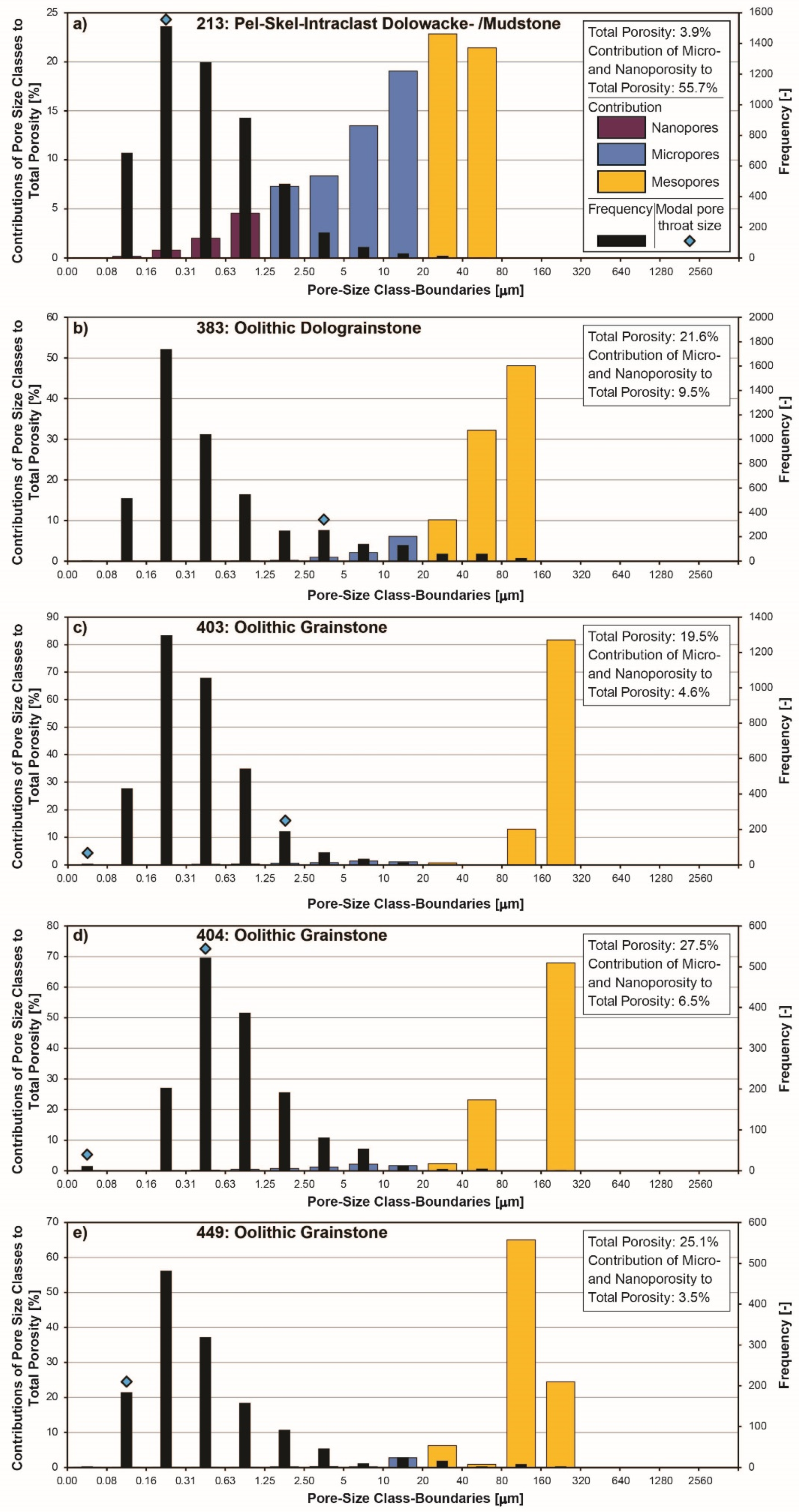




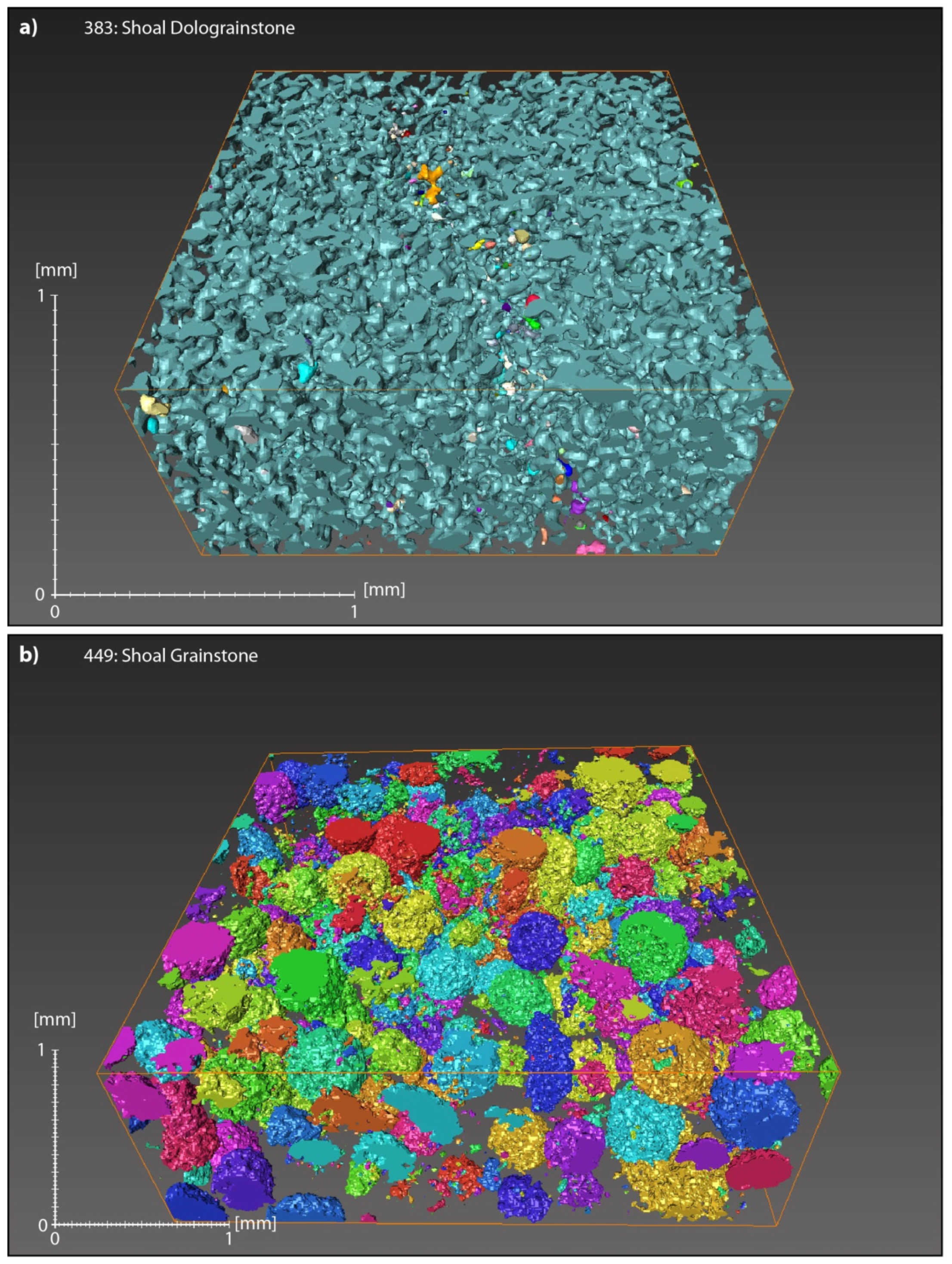
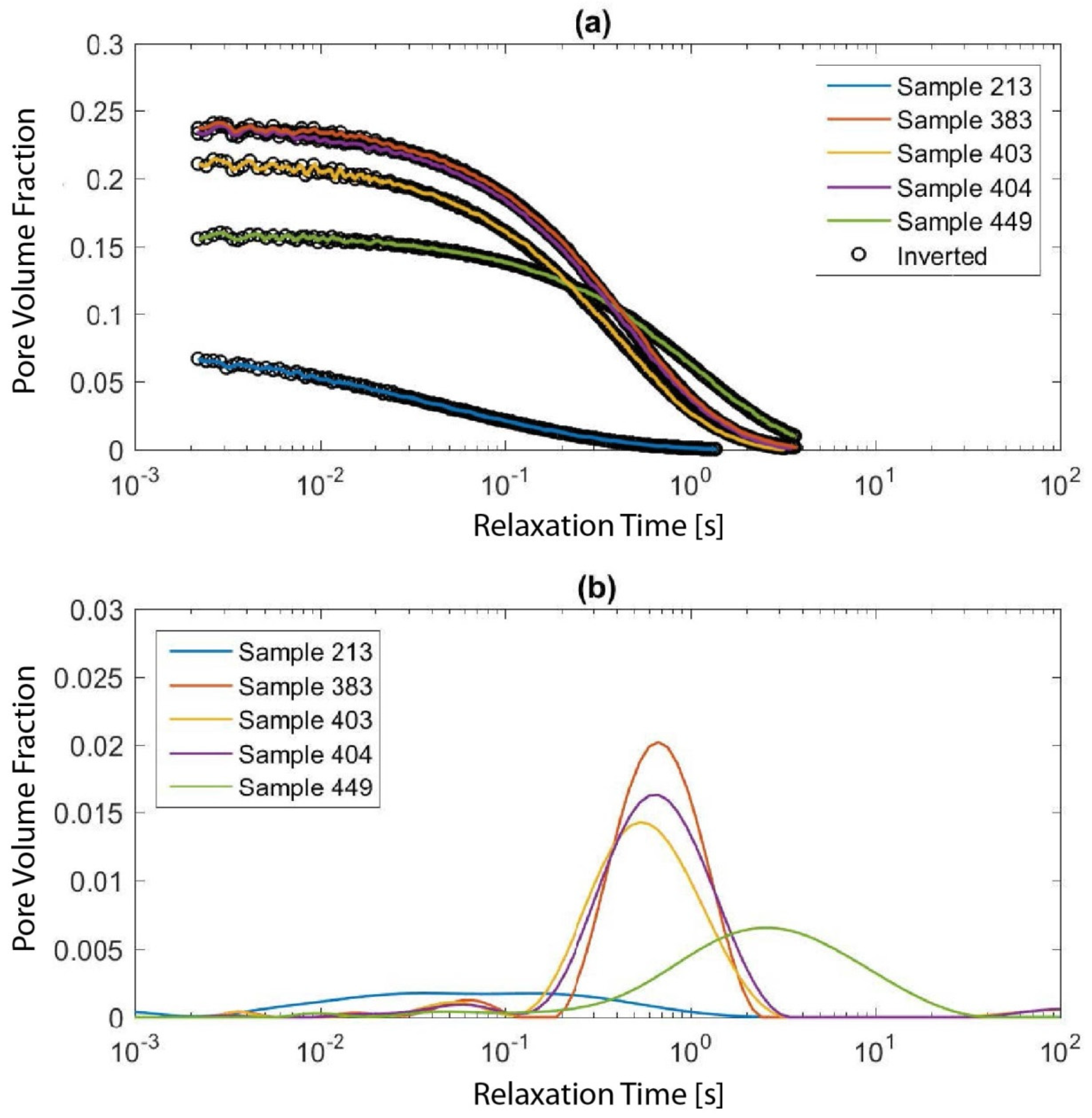
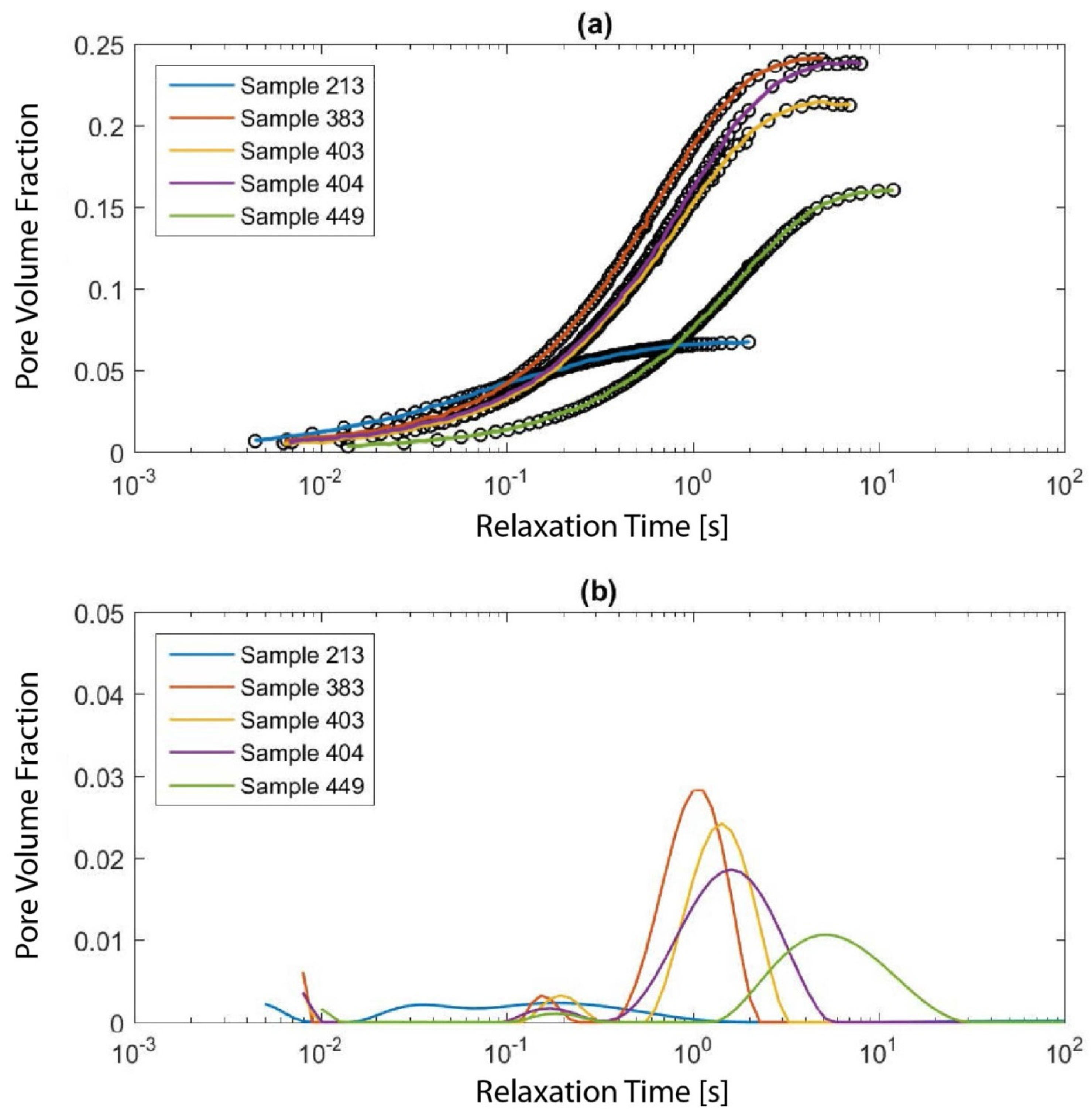
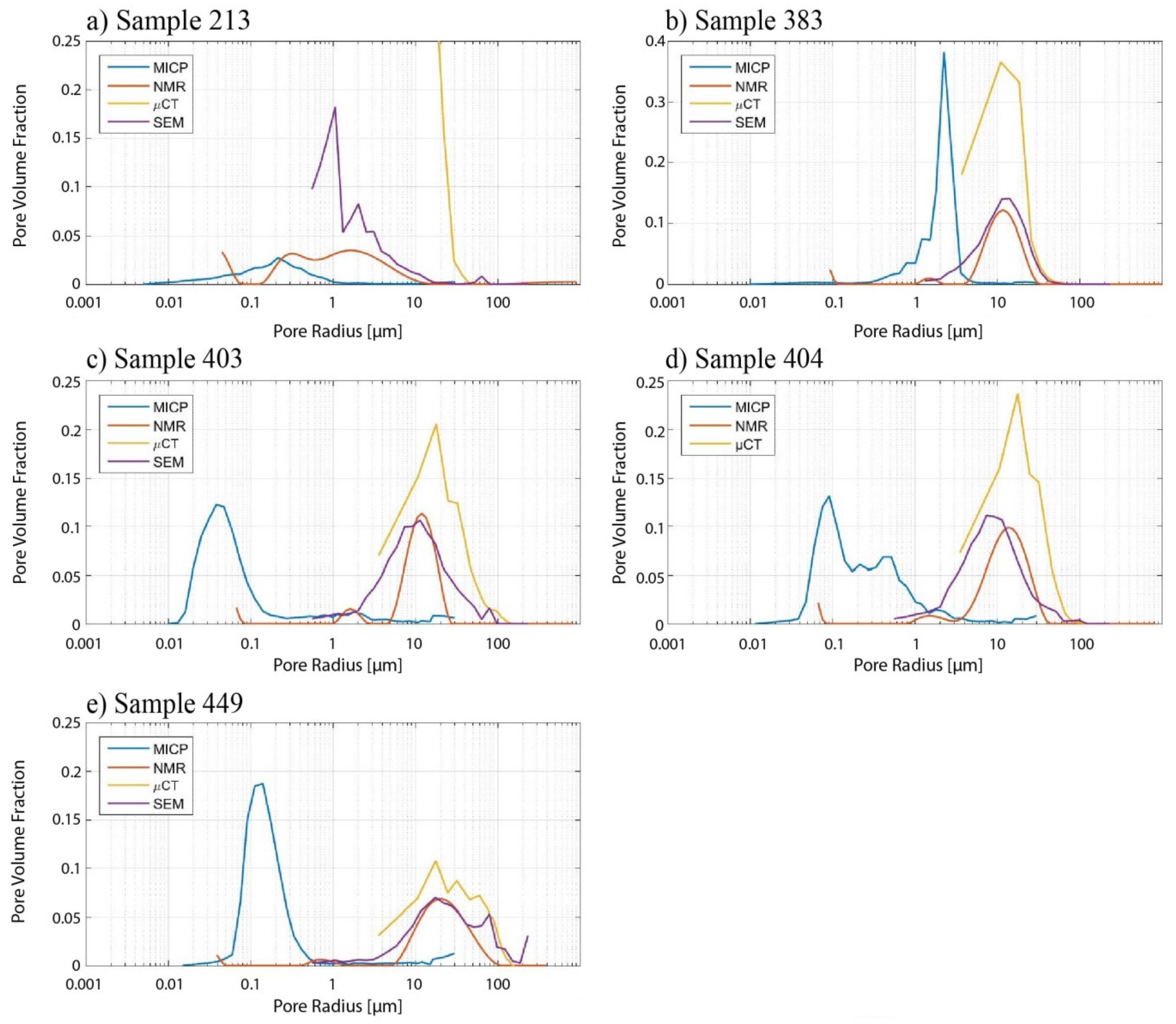

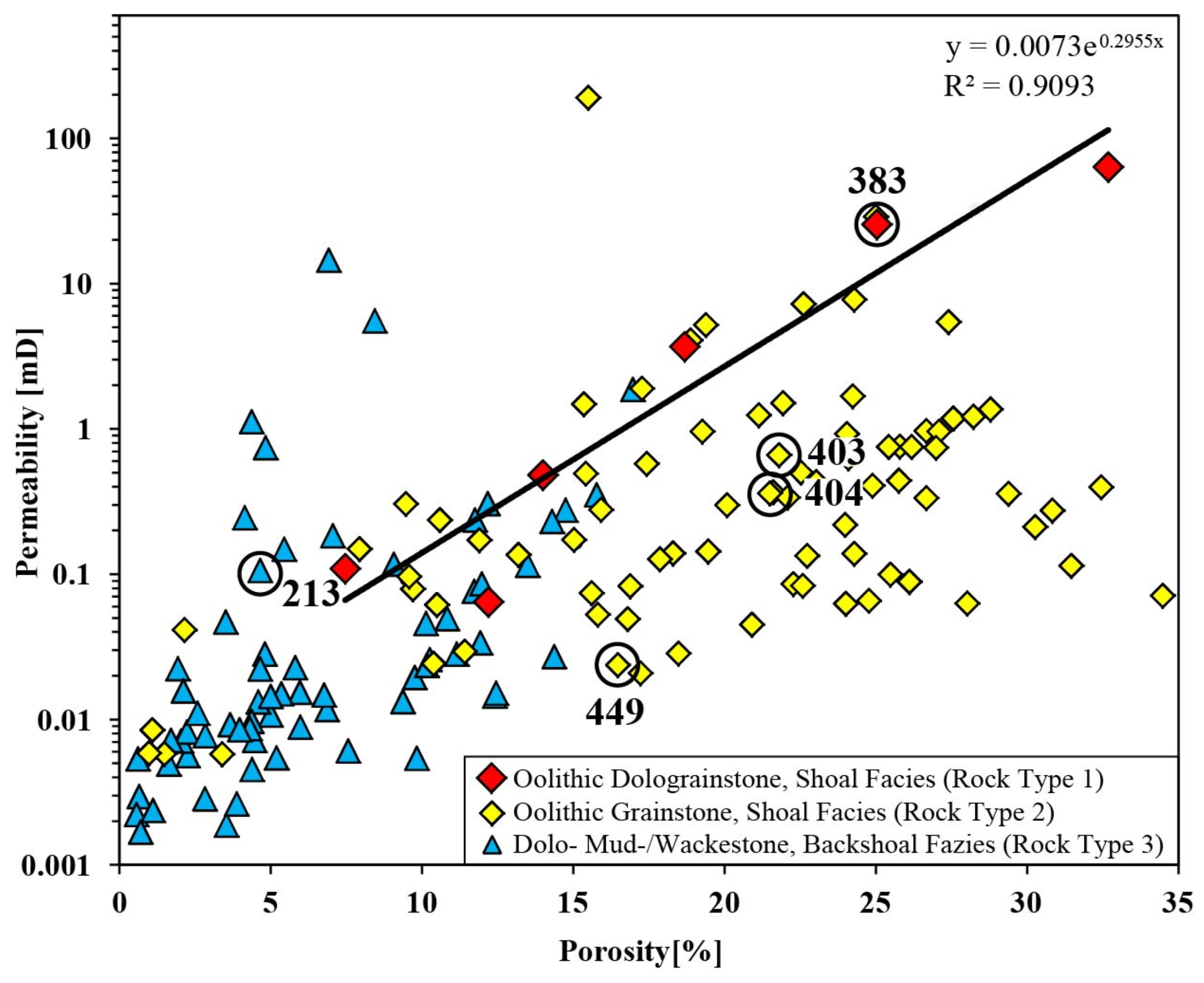
| Lithofacies Types | Massive to Burrowed to Bioturbated Pel-Skel-Intraclast Mud-/Wackestone | Cross-Bedded Oolitic Grainstone |
|---|---|---|
| Samples | 213 | 383, 403, 404 and 449 |
| Petrography | Figure 4 | Figure 5 and Figure 6 |
| Components | Heterolithics, peloids, intraclasts and oncoids, mudstone intraclasts, abundant gastropods, thin-shelled bivalves, ostracods, and miliolids; may include subtidal evaporates | Ooids, peloids, high diversity fauna of gastropods, thick-shelled bivalves, bryozoans, corals, shell debris highly abraded |
| Sedimentary structures | Moderate to poorly sorted mud-/wackestone, peloids, intraclasts and oncoids, variably bioturbated, normal grading, clay drapes | Moderately well sorted, peloidal and oolitic grainstones, well developed trough and planar cross stratified |
| Major diagenetic processes | Cementation, dissolution and fracturing | Dominated by dissolution, cementation, stylolitization, fractures, and dolomitization |
| Pore types | Includes fracture, intercrystalline, and vuggy pores | Dominantly moldic pores, intragranular and intercrystalline pores |
| Depositional environment | Low-energy, shallow water, with semi-restricted circulation of marine waters associated with backshoal to intershoal lagoons frequently influenced by storm washovers | Proximal incipient to fully developed shoal or bar complexes within the high-energy inner to mid-ramp environment |
| Rock types | 3 | 1 and 2 |
| Sample | 213 | 383 | 403 | 404 | 449 |
|---|---|---|---|---|---|
| Lithofacies association | back shoal | shoal | shoal | shoal | shoal |
| Dominant mineralogy | dolomitic | dolomitic | limestone | limestone | limestone |
| Dunham class | wackestone | grainstone | grainstone | grainstone | grainstone |
| T2 Inter echo time [µs] | 231 | 231 | 231 | 231 | 231 |
| No. of echoes | 6000 | 14,000 | 14,000 | 16,000 | 1600 |
| Sample | 213 | 383 | 403 | 404 | 449 |
|---|---|---|---|---|---|
| Lithofacies association | back shoal | shoal | shoal | shoal | shoal |
| Dominant mineralogy | dolomitic | dolomitic | limestone | limestone | limestone |
| He porosity [%] | 5 | 25 | 21.6 | 21.8 | 17.2 |
| SEM porosity [%] | 3.9 | 21.6 | 19.5 | 27.5 | 25.1 |
| SEM micro- and nanoporosity [% of total porosity] | 55.7 | 9.5 | 4.6 | 6.5 | 3.5 |
| MICP porosity [%] | 6.8 | 23.3 | 19.5 | 23.5 | 22.4 |
| NMR total porosity [%] | 6.7 | 24.1 | 21.4 | 23.8 | 16 |
| NMR intercrystalline porosity [%] | 6.4 | 10 | 4 | 5.1 | 0.9 |
| NMR moldic porosity [%] | 0.3 | 14.1 | 17.4 | 18.7 | 0.15 |
| CT porosity [%] | 1.7 | 16.5 | 20.4 | 22.7 | 22.5 |
| He permeability [mD] | 0.24 | 30.6 | 0.56 | 0.98 | 0.04 |
| MICP modal pore-throat radius [µm] | 0.2 | 3 | 0.04, 2 | 0.08, 0.46 | 0.13 |
| Hydraulic radius [µm] (Equation (2)) | 0.23 | 1.39 | 0.26 | 0.32 | 0.12 |
| Sample | 213 | 383 | 403 | 404 | 449 |
|---|---|---|---|---|---|
| Lithofacies association | back shoal | shoal | shoal | shoal | shoal |
| Dominant mineralogy | dolomitic | dolomitic | limestone | limestone | limestone |
| Water resistivity [Ohm m] | 0.0538 | 0.0532 | 0.0532 | 0.0538 | 0.0532 |
| DC resistivity [Ohm m] | 9.875 | 2 | 5.007 | 4.193 | 17.175 |
| Formation factor [-] | 183.7 | 37.6 | 94.1 | 78.0 | 322.9 |
| Cementation exponent [-] | 1.79 | 2.62 | 2.965 | 2.86 | 3.29 |
| Tortuosity [-] | 3.15 | 3.07 | 4.51 | 4.13 | 7.45 |
| Surface relaxivity [m/s] | 3 × 10−6 | 3.9 × 10−6 | 2.8 × 10−6 | 2.8 × 10−6 | 1.3 × 10−6 |
© 2019 by the authors. Licensee MDPI, Basel, Switzerland. This article is an open access article distributed under the terms and conditions of the Creative Commons Attribution (CC BY) license (http://creativecommons.org/licenses/by/4.0/).
Share and Cite
Smodej, J.; Lemmens, L.; Reuning, L.; Hiller, T.; Klitzsch, N.; Claes, S.; Kukla, P.A. Nano- to Millimeter Scale Morphology of Connected and Isolated Porosity in the Permo-Triassic Khuff Formation of Oman. Geosciences 2020, 10, 7. https://doi.org/10.3390/geosciences10010007
Smodej J, Lemmens L, Reuning L, Hiller T, Klitzsch N, Claes S, Kukla PA. Nano- to Millimeter Scale Morphology of Connected and Isolated Porosity in the Permo-Triassic Khuff Formation of Oman. Geosciences. 2020; 10(1):7. https://doi.org/10.3390/geosciences10010007
Chicago/Turabian StyleSmodej, Jörg, Laurent Lemmens, Lars Reuning, Thomas Hiller, Norbert Klitzsch, Steven Claes, and Peter A. Kukla. 2020. "Nano- to Millimeter Scale Morphology of Connected and Isolated Porosity in the Permo-Triassic Khuff Formation of Oman" Geosciences 10, no. 1: 7. https://doi.org/10.3390/geosciences10010007





